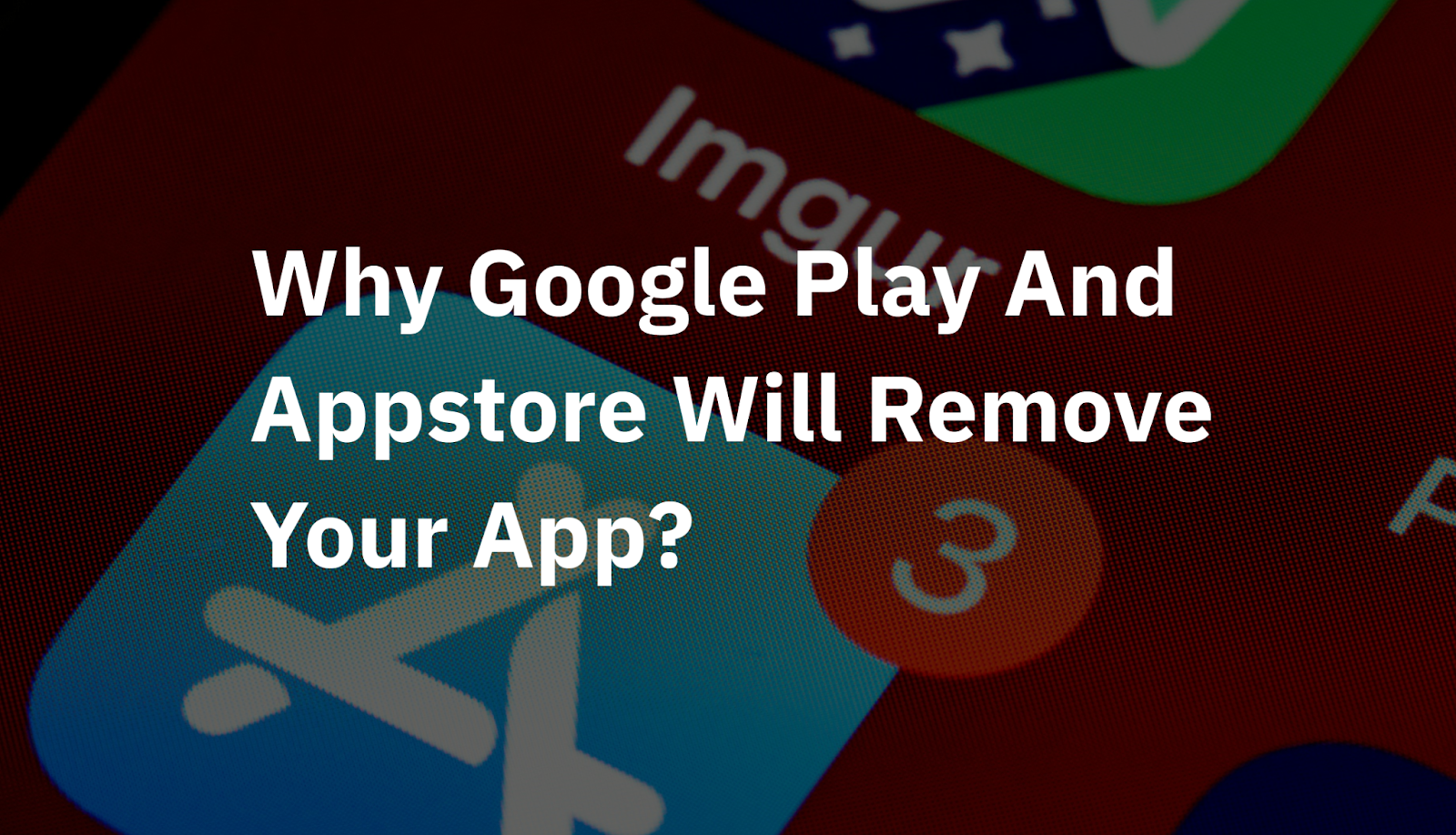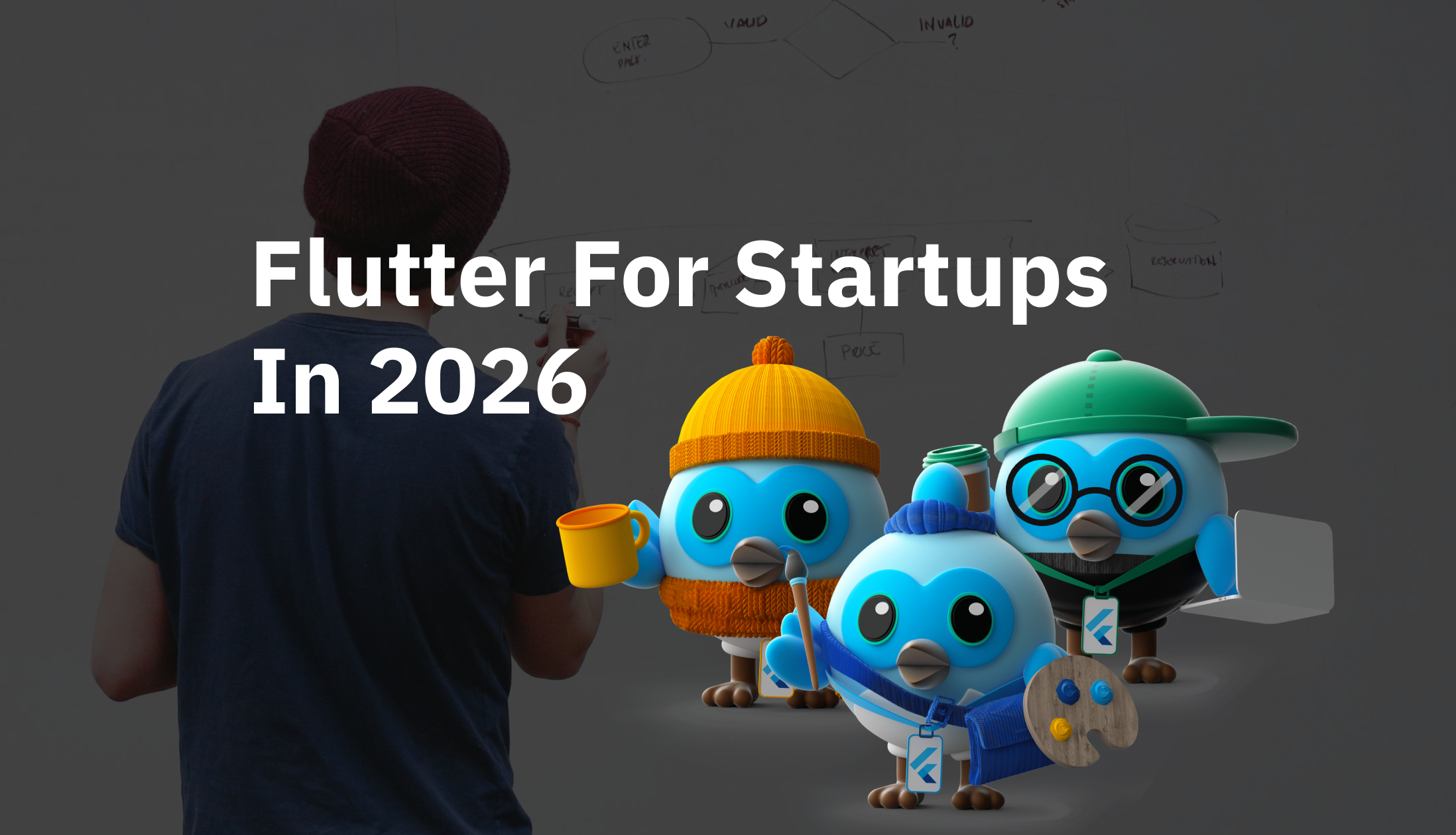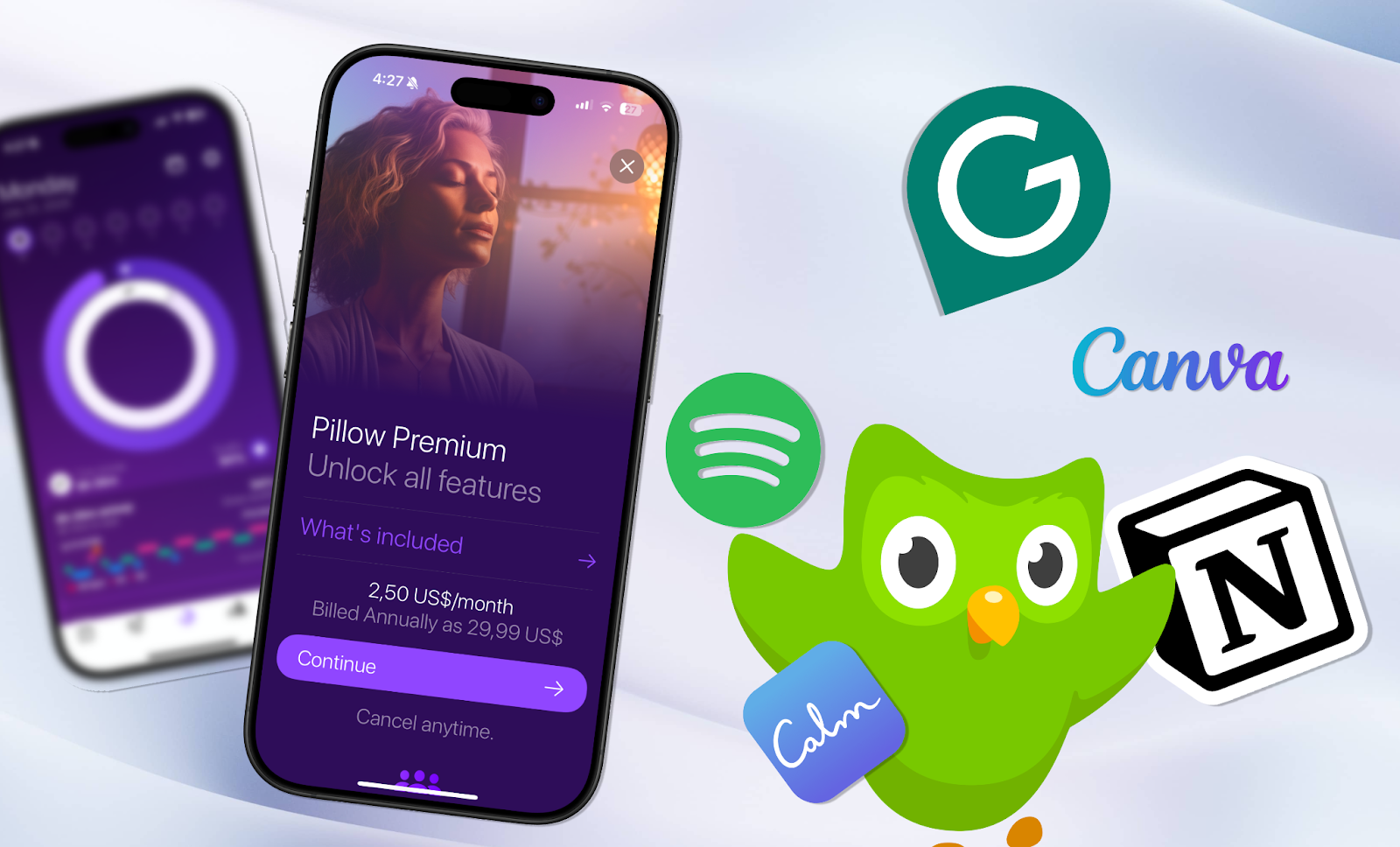
Subscriptions, Ads, or Freemium? Choosing the Right Business Model for Your App
In 2025, making money from an app isn’t about adding random ads or charging a one-time download fee. The real challenge is finding a revenue model that fits the product, feels natural to users, and supports long-term growth.
Mobile apps are no longer just digital tools — they’ve become full-scale business platforms. When built and monetized strategically, they create new revenue streams, strengthen customer engagement, and unlock long-term opportunities.
In this article, we break down the most popular and promising monetization models, along with their pros and cons, to make the landscape easier to navigate.
So, what is app monetization?
App monetization is the process of generating revenue from a mobile app — either directly from users (through subscriptions, in-app purchases, or pay-per-download models) or indirectly, through advertising, affiliate marketing, data licensing, or other methods. The right strategy depends on the app’s audience, category, and overall business goals. Often, combining multiple models works best.
According to Statista, in-app advertising remains the most widely used monetization method, with over 60% of U.S. publishers relying on it. Subscriptions and in-app purchases are also rapidly growing, especially among non-gaming apps, thanks to their recurring revenue and strong retention potential. Paid downloads, on the other hand, now account for only a small share of global apps, making hybrid or freemium models more attractive for most businesses.
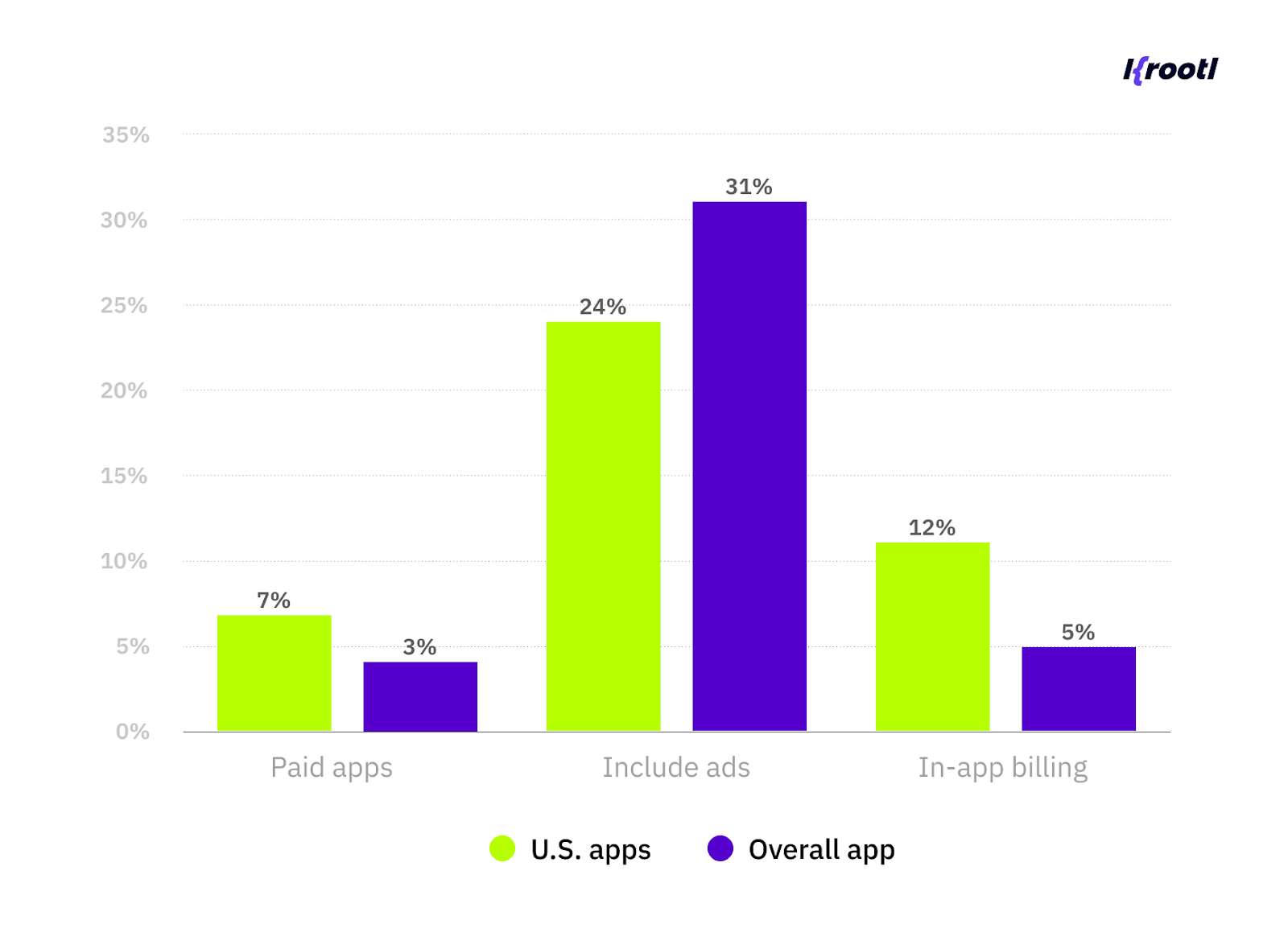
App Monetization Models: A Quick Overview
Choosing the right monetization strategy can be tricky. Should revenue come from ads, in-app purchases, or a mix of both? The answer depends on the product, audience, and long-term vision.
Before we dive into the ten most common mobile app monetization models, along with their pros, cons – here’s a quick snapshot of the most popular options in 2025. This overview will help set the stage for selecting the model (or combination of models) that makes the most sense for your app.
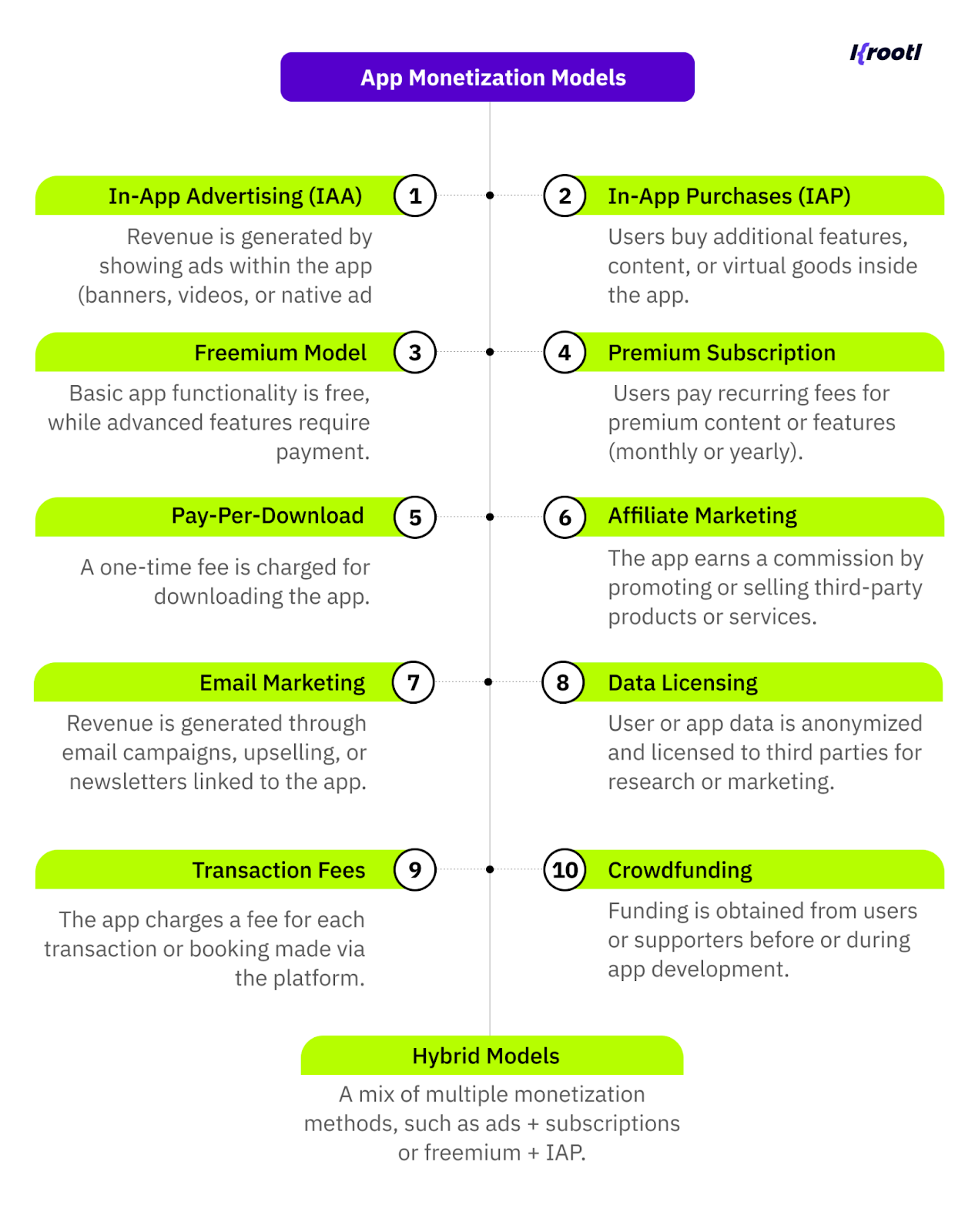
1. In-App Advertising (IAA)
In-app advertising is one of the most popular and profitable ways to generate revenue from mobile apps. It works by displaying ads (banners, videos, or native formats) through ad networks. Revenue is earned every time a user views, clicks, or performs an action (such as installing another app).
Types of In-App Advertising:
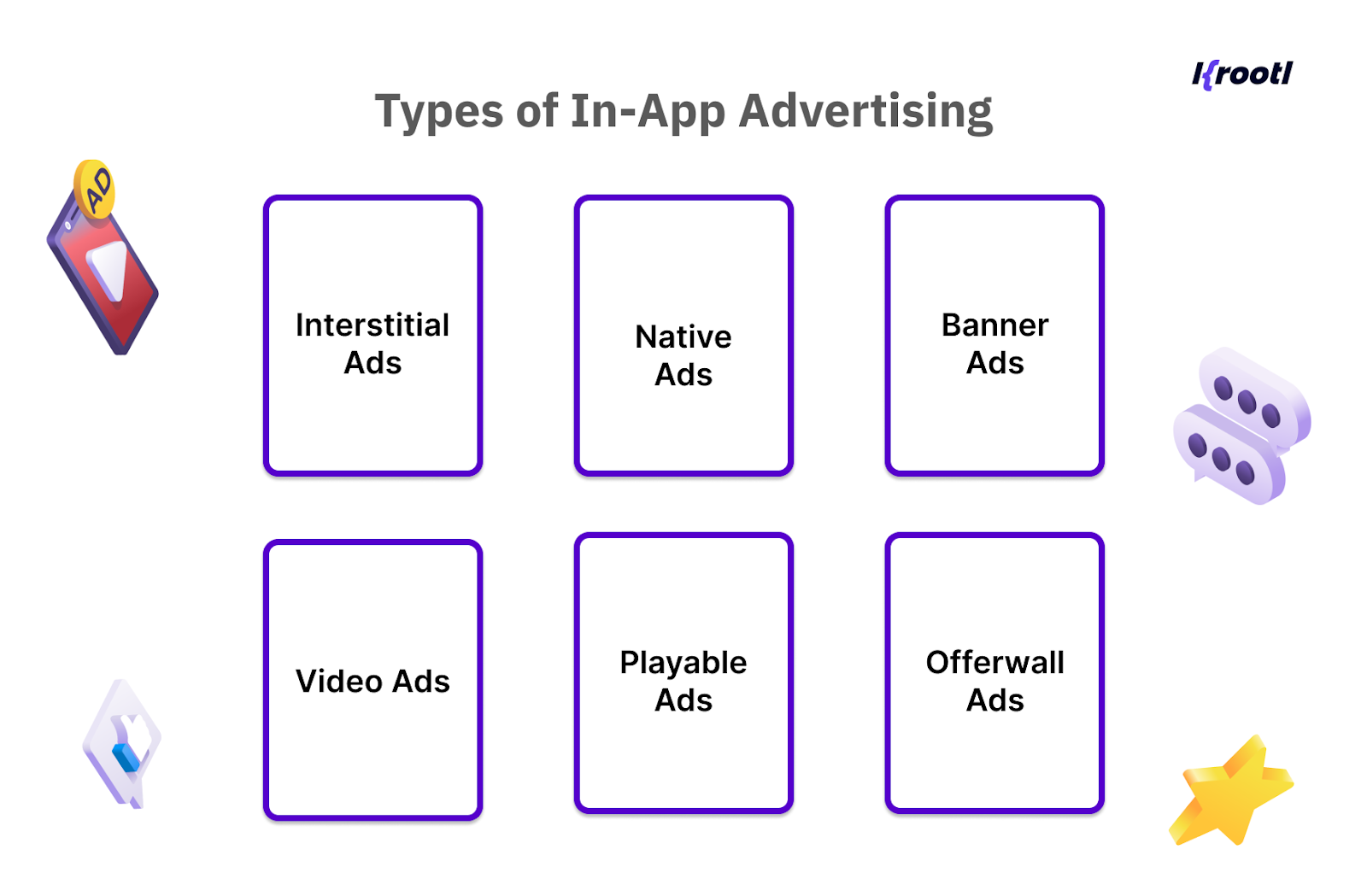
- Interstitial Ads
Full-screen ads shown at natural breaks (e.g., between game levels). They’re more engaging than banners and reduce the risk of “banner blindness” - Native Ads
Blend seamlessly with the app’s design and content (e.g., ads in social feeds). They feel organic, improving engagement and retention - Banner Ads
Small rectangular ads (static or interactive) placed at the top or bottom of the screen. Easy to integrate but have lower click-through rates - Video Ads
Short video ads, often used as rewards (e.g., watch to unlock an extra life). Highly engaging and effective when timed between app sessions
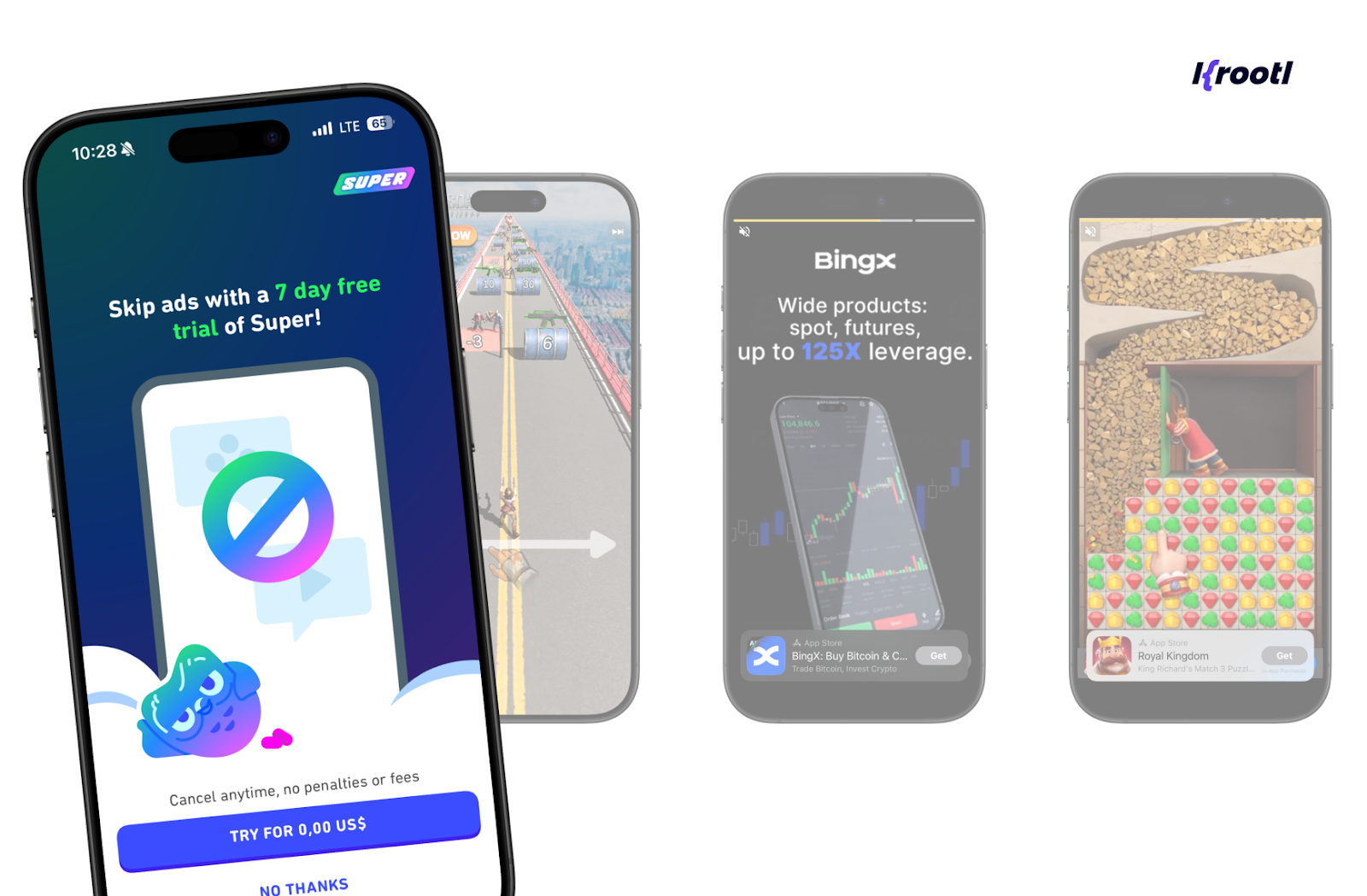
- Playable Ads
Interactive mini-games or demos that let users try a product or game before installing. Popular in the gaming industry - Offerwall Ads
Lists of tasks (e.g., surveys, watching a video) that reward users with in-app currency or extra features. Boosts retention and engagement
How It Works
Developers integrate ad SDKs (e.g., Google AdMob or Facebook Audience Network) into the app. Advertisers pay based on impressions (CPM), clicks (CPC), or completed actions (CPA). The more valuable the user action, the higher the revenue.
Example
A free weather app that shows banner ads at the bottom of the screen and interstitial ads between forecast updates.
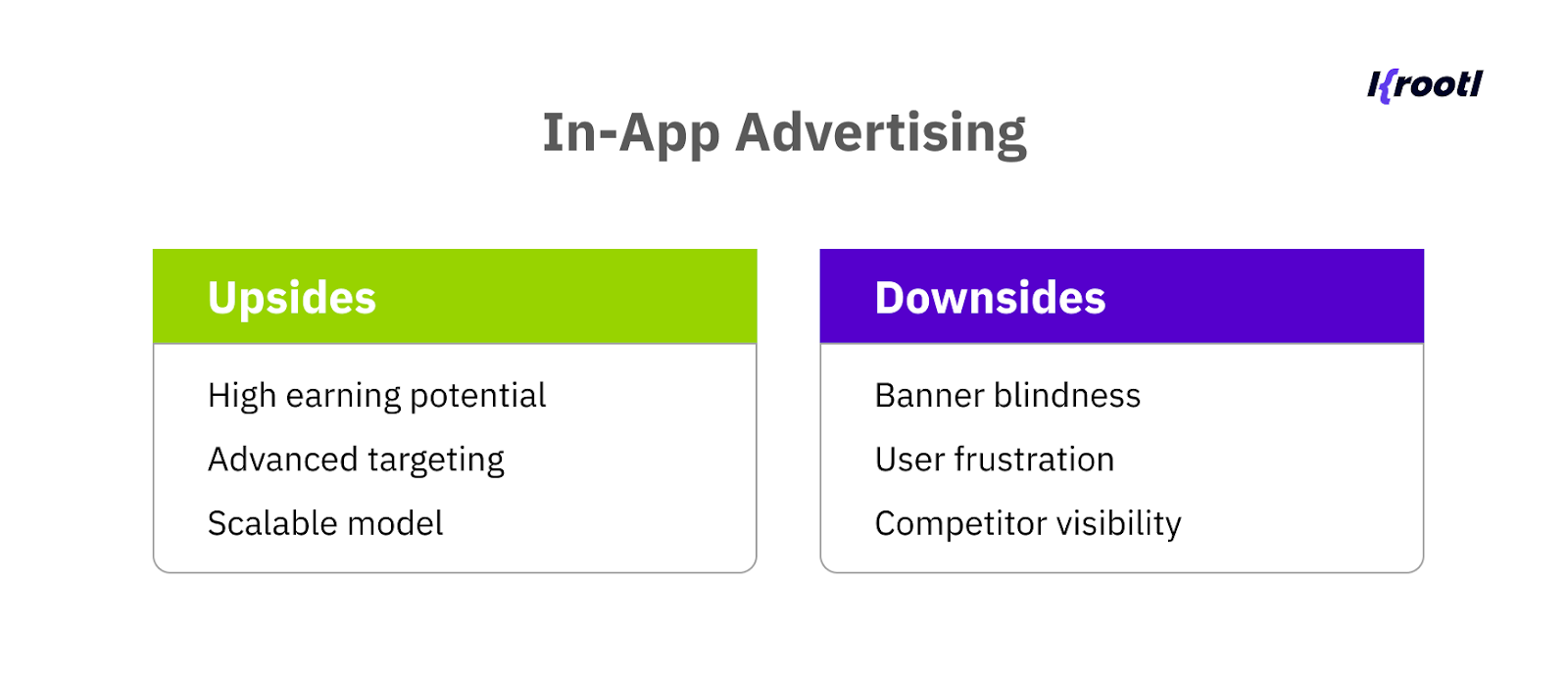
Pros:
- High earning potential: Interstitial ads can generate high eCPM, especially in markets like the U.S.
- Advanced targeting: Ad networks allow personalized ad delivery, improving engagement
- Scalable model: Works for both small indie apps and large platforms
Cons:
- Banner blindness: Users tend to ignore standard banners
- User frustration: Poorly timed ads can disrupt the experience
- Competitor visibility: Rival apps might appear in ad placements
*The global in-app advertising market, valued at $151 billion in 2022, is projected to reach ~ $500 billion by 2033.
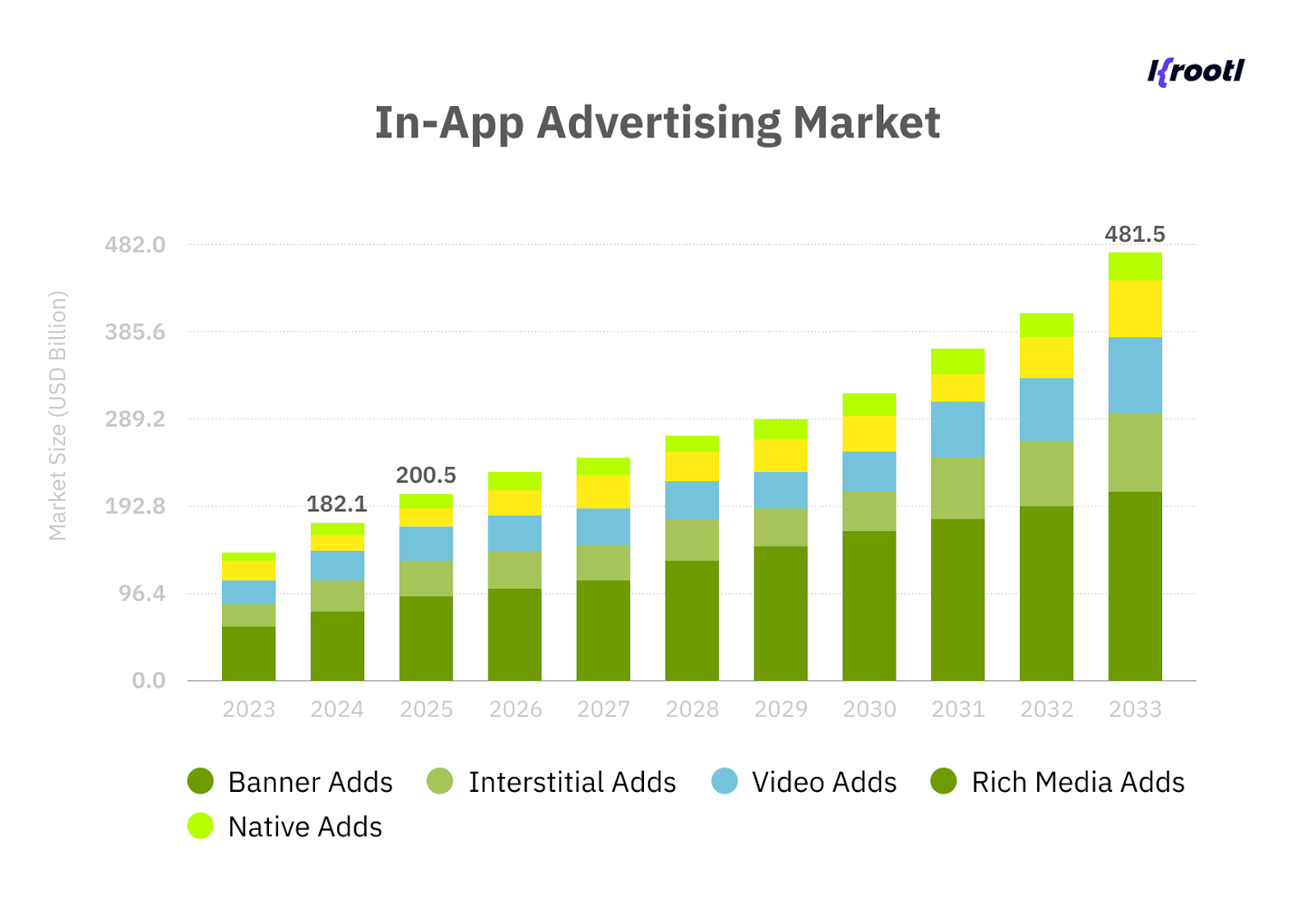
2. In-App Purchases (IAP)
In-app purchases (IAP) are one of the most effective monetization methods for apps, allowing users to buy additional content, features, or virtual goods directly inside the app. This model is especially popular in gaming, creative apps, and any product with add-ons or premium content.
Types of In-App Purchases:
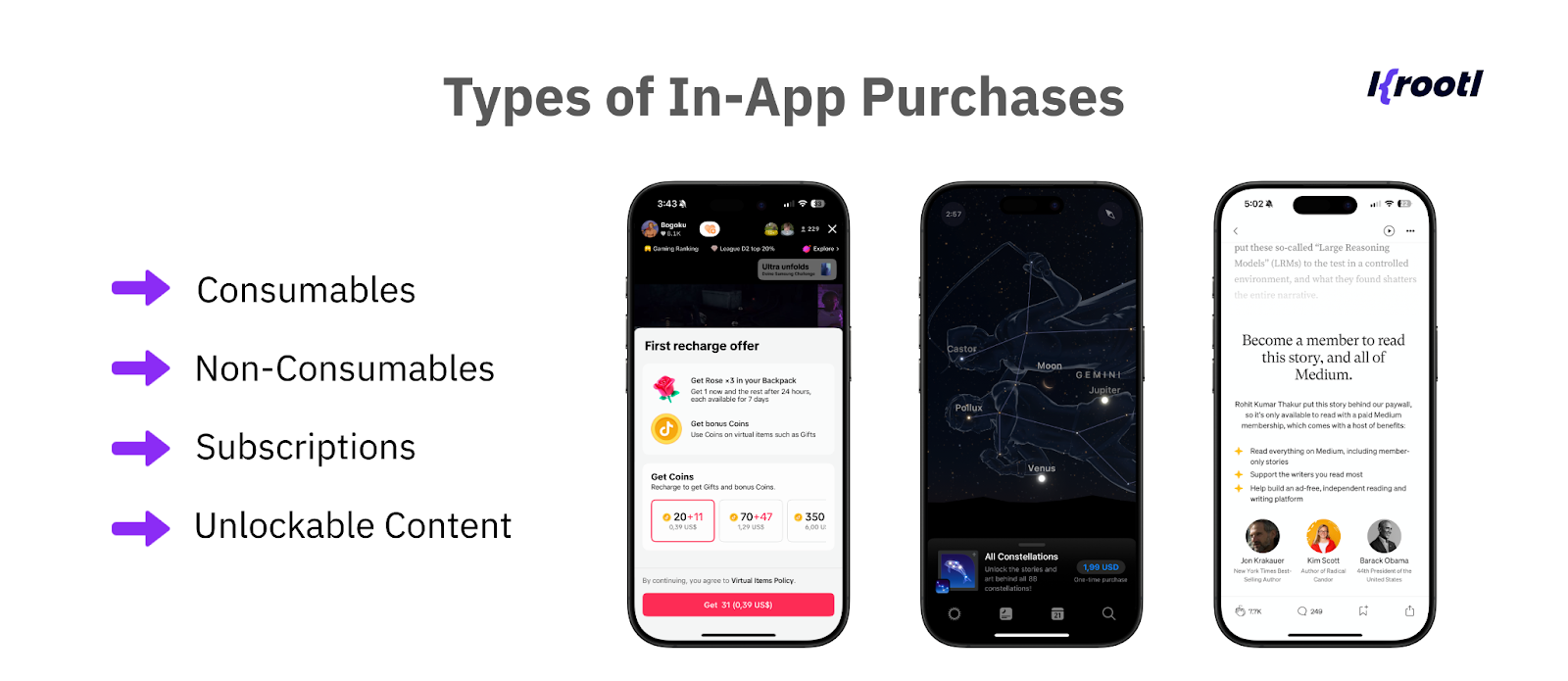
- Consumables: Items that can be used once and repurchased (e.g., in-game currency or extra lives).
- Non-Consumables: One-time purchases that unlock permanent features (e.g., removing ads or unlocking premium themes).
- Subscriptions: Recurring payments for ongoing access to content or services.
- Unlockable Content: Levels, features, or extras that enhance the app’s core experience.
How It Works
Developers integrate payment gateways via Apple App Store or Google Play billing. Users pay directly through the platform, and the app owner receives revenue after the store’s commission (typically 15–30%).
Example
A mobile game where players can purchase extra lives, character skins, or virtual currency to progress faster.
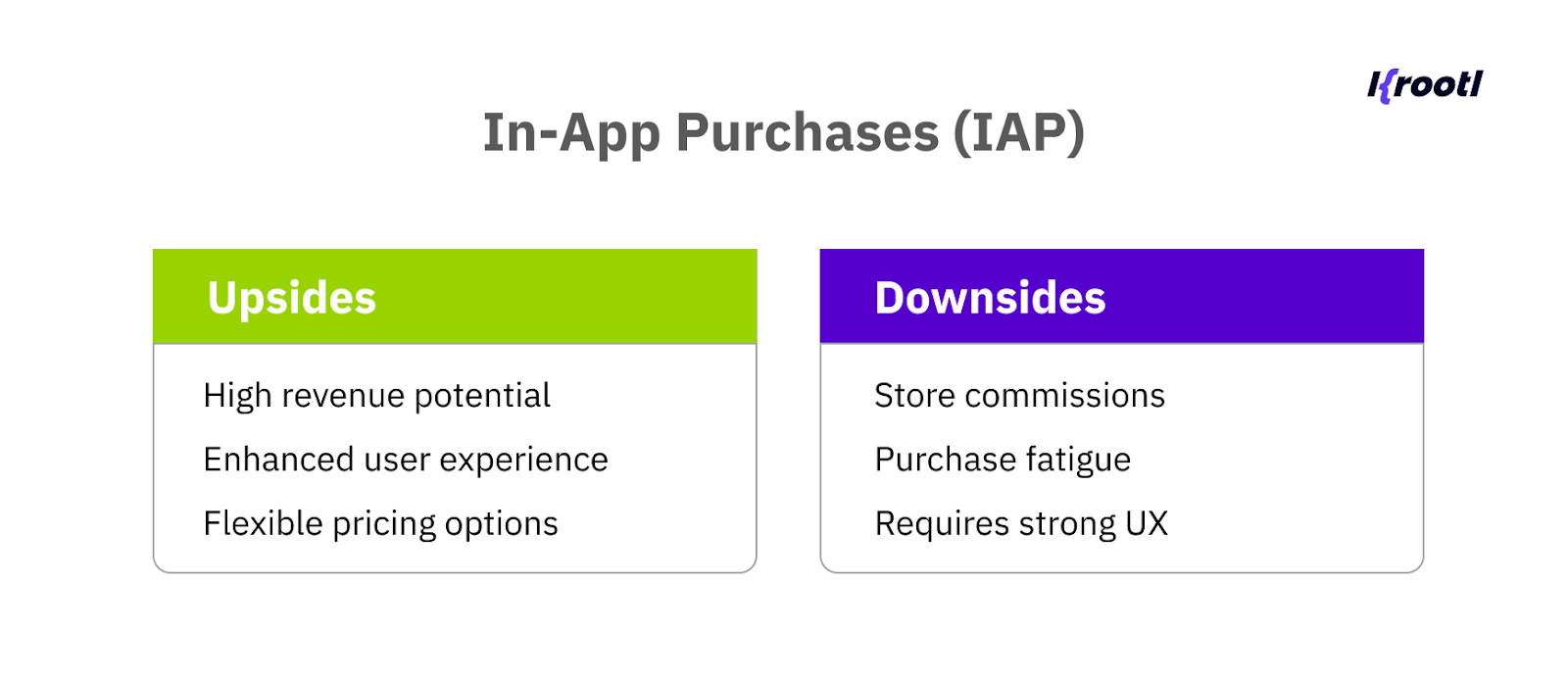
Pros:
- High revenue potential: Particularly effective in gaming and creative tools
- Enhanced user experience: Users pay only for what they need
- Flexible pricing options: Offers both small and premium add-ons
Cons:
- Store commissions: Apple and Google take a cut (15–30%)
- Purchase fatigue: Users may be hesitant to make frequent small payments
- Requires strong UX: Poorly integrated IAP can harm retention
3. Freemium Model
The freemium model combines free access with premium upgrades. Users can download and use the app’s core features for free, while advanced tools, extra content, or ad-free experiences are locked behind a paywall. This approach is widely used to attract a large user base and convert engaged users into paying customers.
How It Works
The app offers essential features at no cost to encourage adoption. Premium plans or one-time purchases unlock additional value, such as advanced analytics, exclusive content, or customization options. Conversion rates depend on how well the free version demonstrates the app’s value and encourages upgrades.
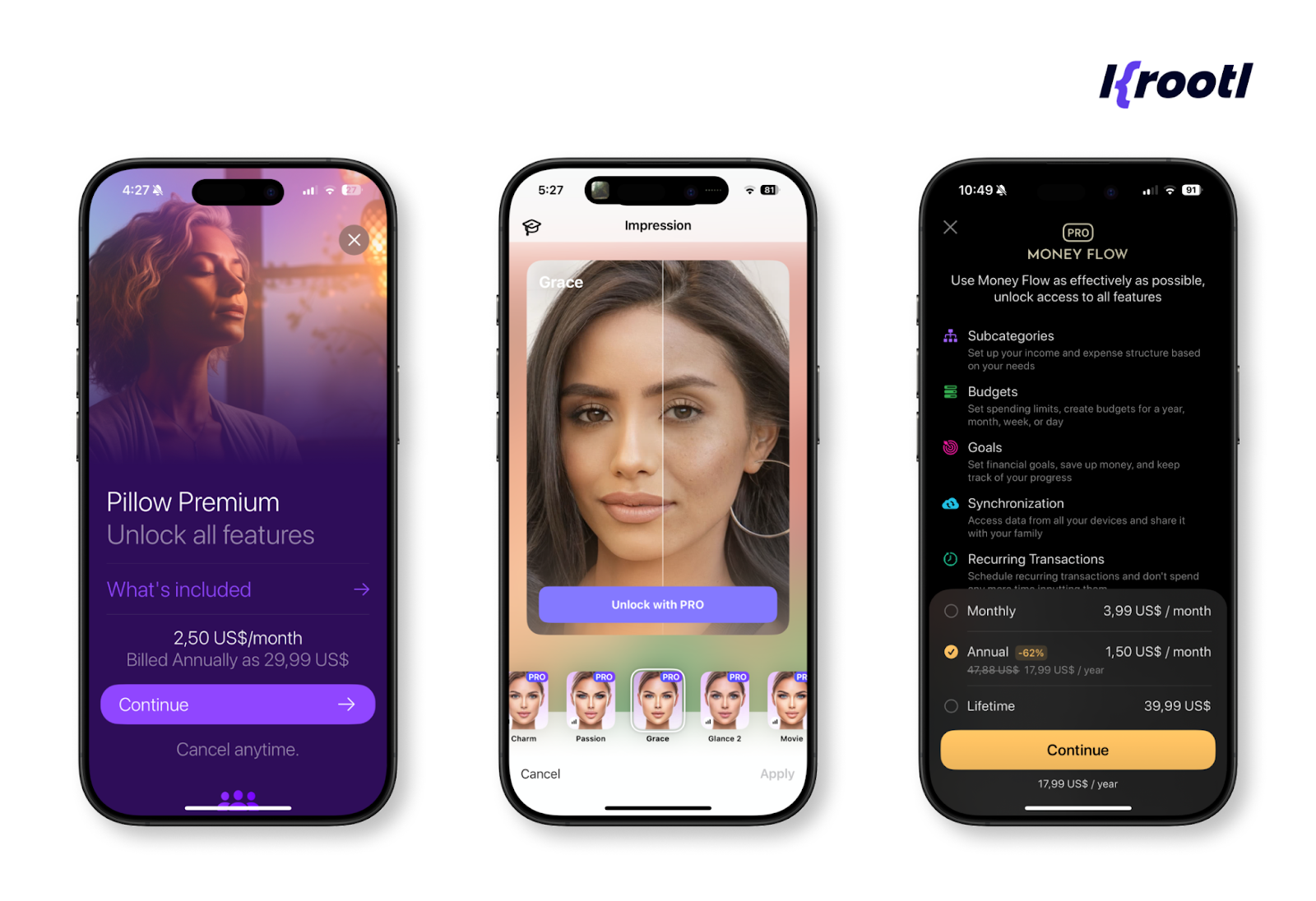
Example
A photo editing app where standard filters are free, but advanced effects, premium templates, or HD exports require upgrading to “Pro.”
Pros:
- Low barrier to entry: Easy for users to start using the app
- Large user base: Encourages rapid growth and brand awareness
- Upselling potential: Engaged users are more likely to upgrade
Cons:
- Revenue relies on a small percentage of paying users (2–5%)
- Constant optimization: Requires fine-tuning between free and paid features
- Can frustrate users if the free tier is too limited
4. Premium Subscription
The premium subscription model generates recurring revenue by charging users a monthly, quarterly, or yearly fee for access to exclusive content, advanced features, or services. It’s widely used in apps where ongoing value is delivered, such as streaming, fitness, and productivity tools.
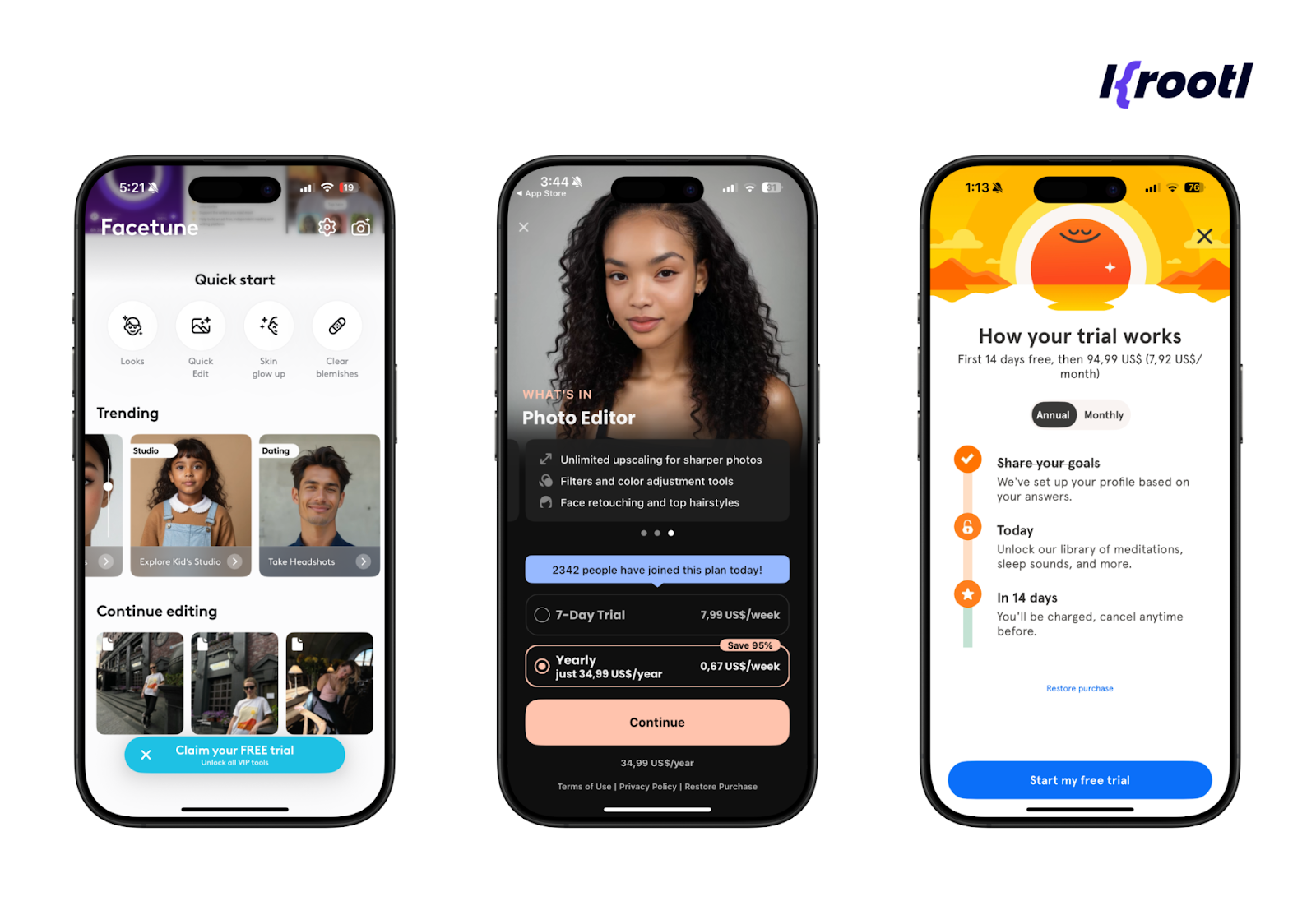
How It Works
The app offers a subscription plan (or multiple tiers) that provides users with continuous access to premium features or content. Common structures include free trials to attract users, with automatic renewal after the trial period. Platforms like the App Store and Google Play handle the billing and renewals.
Example
A meditation ugh where free users access basic sessions, but premium subscribers unlock the full library of guided meditations and courses.
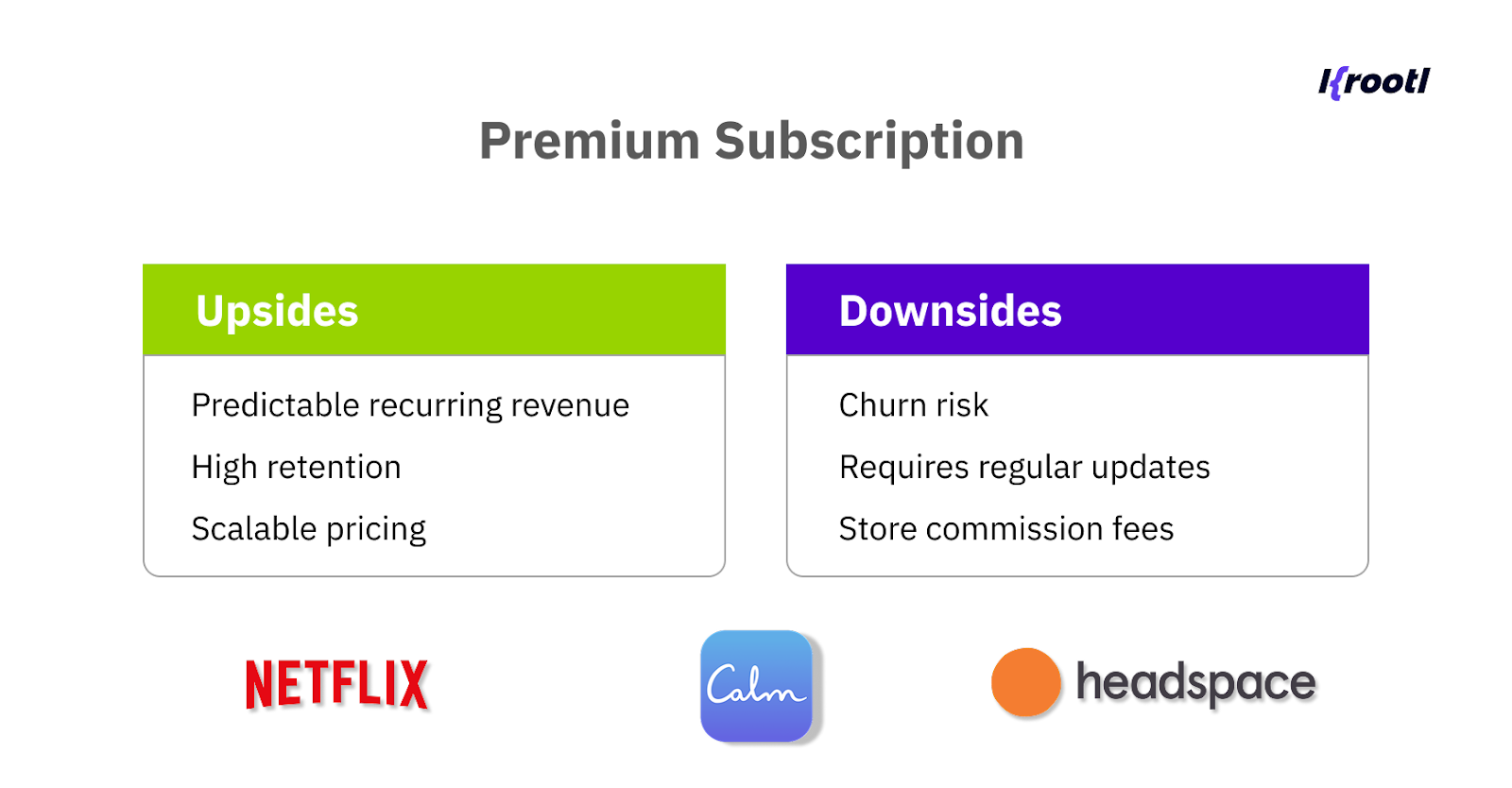
Pros:
- Predictable recurring revenue: Subscriptions create stable cash flow
- High retention: Users stay engaged to get ongoing value
- Scalable pricing: Multiple plans allow targeting different segments
Cons:
- Churn risk: Users may cancel if they don’t see continuous value
- Requires regular updates: Content or features must stay fresh to retain subscribers
- Store commission fees (15–30%)
5. Pay-Per-Download
The pay-per-download model (or paid app model) generates revenue through a one-time fee charged upfront when users download the app. While less common today, it still works well for niche apps or tools that deliver clear, high-value features without ongoing costs.
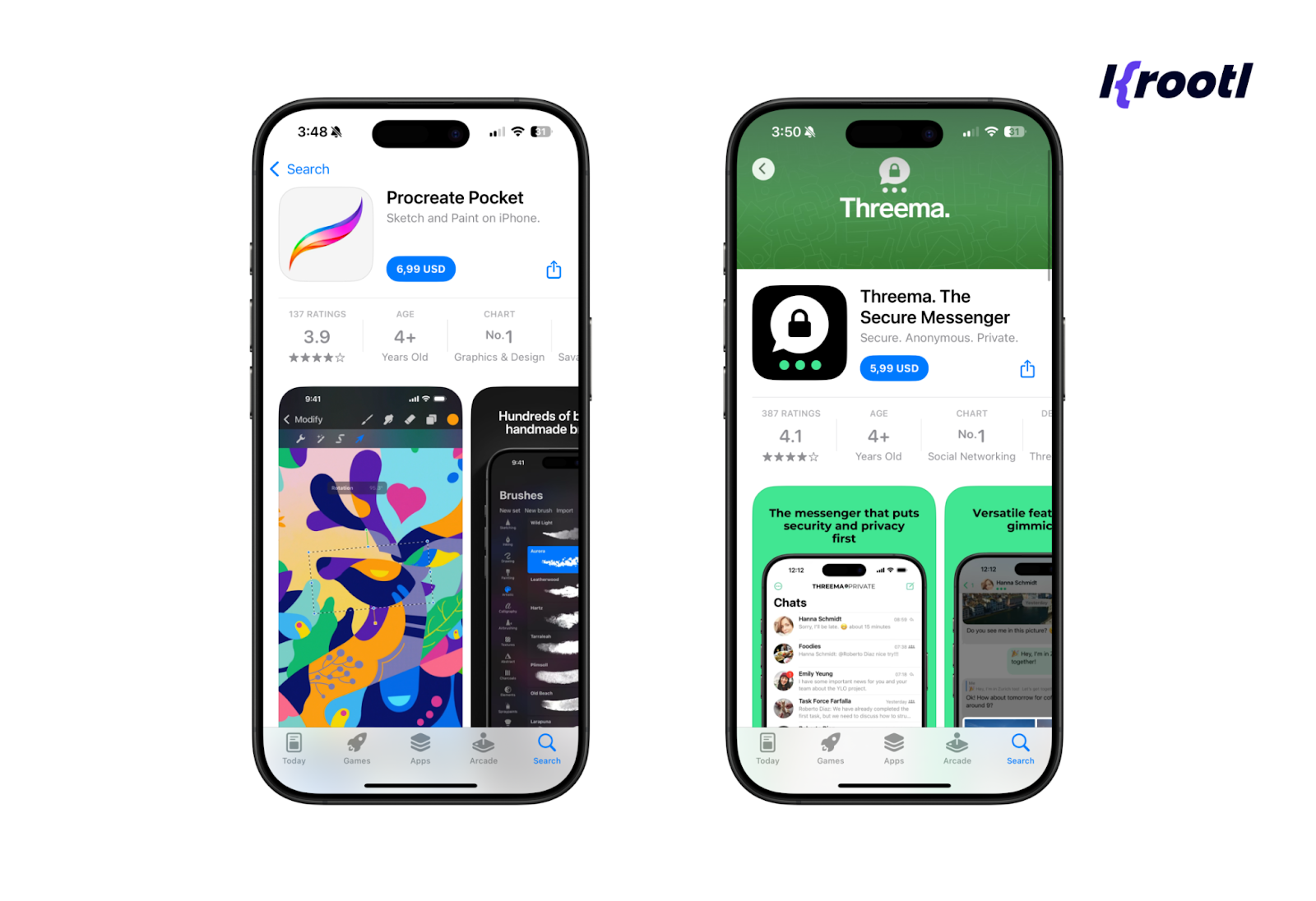
How It Works
Users pay a fixed price in app stores (Google Play, App Store) to gain full access. There are no additional payments or ads, which simplifies the user experience. Success heavily depends on strong app store optimization, marketing, and positive reviews to justify the upfront cost.
Example
A professional photo retouching app that costs $4.99 to download but includes all features without in-app purchases.
Pros:
- Instant revenue per download: No need to rely on user engagement over time
- Ad-free experience: Clean and uninterrupted user interface
- Simple monetization: No complex paywalls or subscriptions
Cons:
- High entry barrier: Many users avoid paying upfront without a trial
- Revenue growth is limited by new downloads
- Requires strong marketing and reputation to succeed
6. Affiliate Marketing
The affiliate marketing model generates revenue by promoting third-party products or services within an app. When users make a purchase, sign up, or complete a specific action through the affiliate link, the app earns a commission.
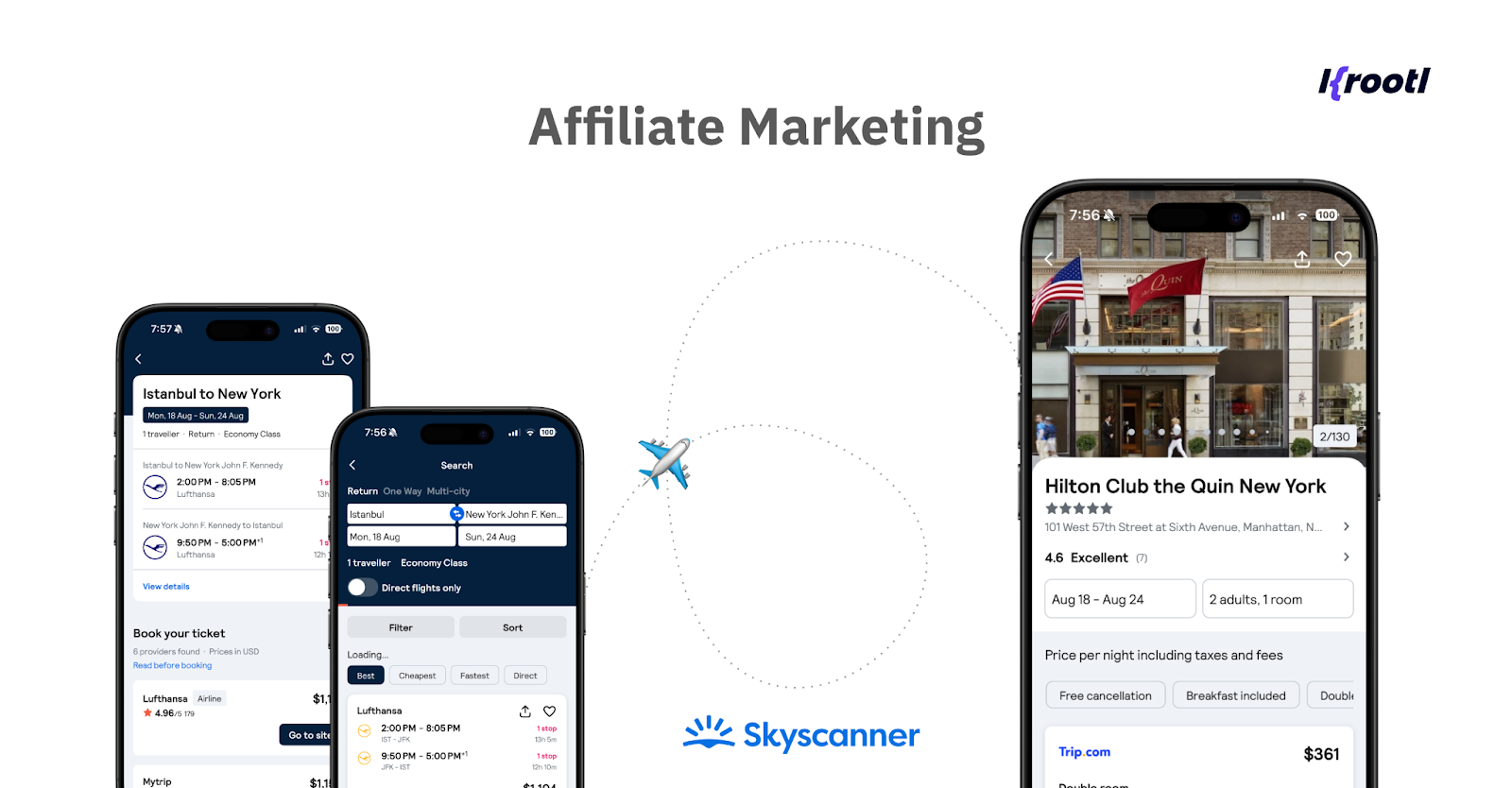
How It Works
Developers integrate affiliate links, banners, or product recommendations that align with their app’s content. Popular affiliate programs include Amazon Associates or PartnerStack. The app earns money based on referral traffic and conversions tracked by the affiliate network.
Example
A recipe app that links ingredients directly to an online grocery store, earning a commission when users purchase via those links.
Pros:
- No upfront cost: Easy to implement with minimal investment
- Passive revenue stream: Earns as long as users engage with the app
- Works well for content-rich apps (e.g., blogs or review platforms)
Cons:
- Lower control over user experience: Poorly matched offers can feel spammy
- Revenue depends on user trust and traffic volume
- Commission rates vary and can be low for some industries
7. Email Marketing
The email marketing model focuses on building a user base and generating revenue through email campaigns, upsells, or promotional content linked to the app. While it’s often used as a secondary monetization method, it can be a powerful tool for nurturing long-term customer relationships.
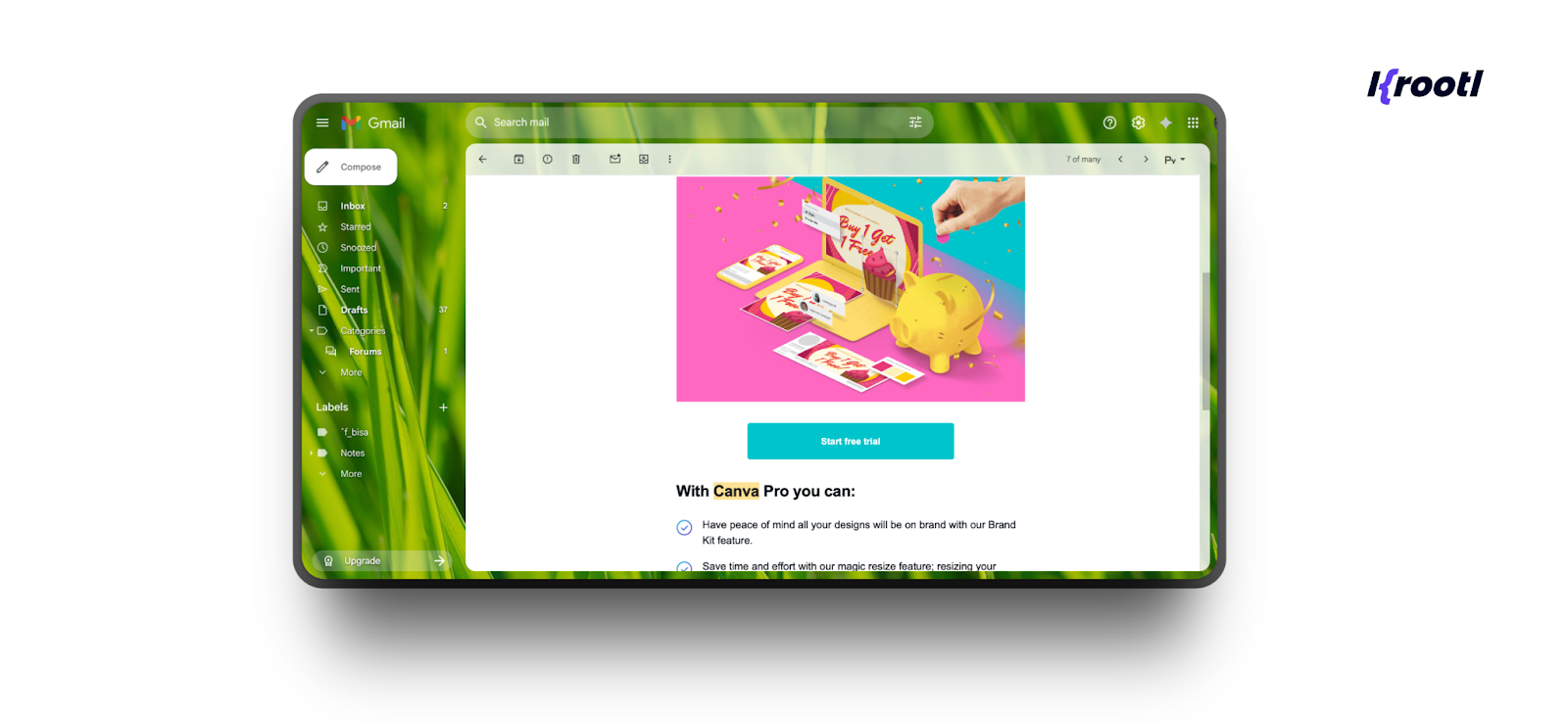
How It Works
The app collects user emails through sign-ups, gated content, or newsletters. These contacts are then targeted with email campaigns to promote premium features, related products, or services. This method is often paired with other monetization models like freemium or subscriptions. Eg. Canva (email upselling for templates and subscriptions).
Example
A design app that sends emails with new template bundles and offers discounts for premium users.
Pros:
- Cost-effective: Low implementation costs with high ROI
- Direct user communication: Build a long-term relationship with your audience
- Supports other monetization models (e.g., IAP or subscriptions)
Cons:
- Relies on user consent and data privacy (GDPR, CCPA)
- Spam risk: Poorly designed campaigns can lead to unsubscribes or user complaints
- Slow revenue growth: Requires a solid email strategy and list-building efforts
8. Data Licensing
The data licensing model monetizes anonymized and aggregated user data by providing insights to third parties, such as research companies, marketers, or analytics firms. This approach is often used in apps that collect large volumes of behavioral or usage data.
How It Works
User data is collected (with proper consent) and anonymized to ensure privacy. This data is then packaged and licensed to organizations that benefit from understanding patterns, trends, or user behavior. Compliance with privacy regulations like GDPR or CCPA is critical to this model.
Example
A fitness app that aggregates user workout trends (anonymously) and licenses the insights to sports equipment companies.
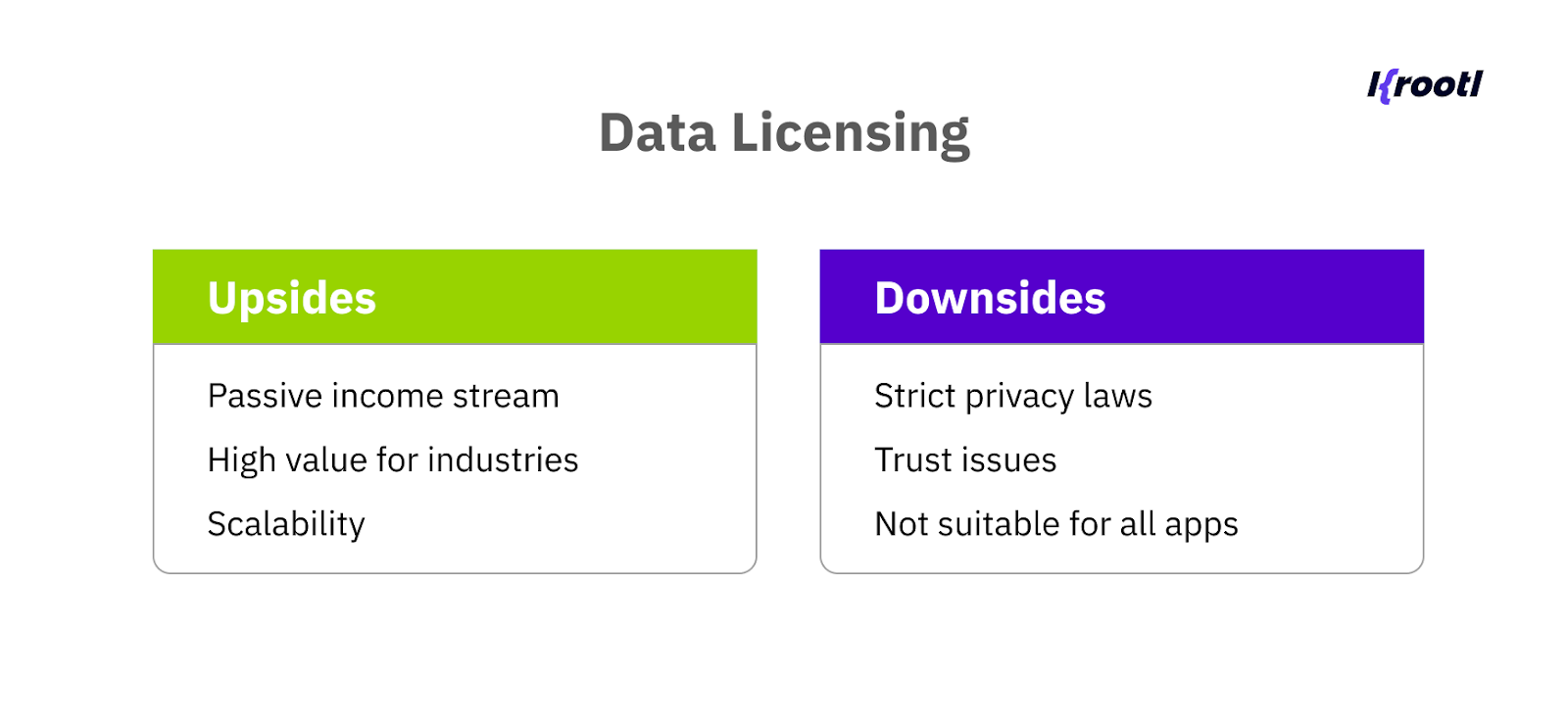
Pros:
- Passive income stream: No disruption to the user experience
- High value for data-driven industries (e.g., e-commerce, finance)
- Scales with the size of the user base
Cons:
- Strict privacy laws: Requires robust data protection and transparency
- Trust issues: Users may abandon apps if data use is unclear
- Not suitable for all apps: Works best for platforms that generate actionable data
9. Transaction Fees
The transaction fee model generates revenue by taking a percentage or flat fee from each transaction processed through the app. This approach is common in marketplaces, fintech platforms, and booking apps where the app acts as an intermediary.
How It Works
Whenever a user makes a purchase, booking, or payment, the app charges a commission on the total transaction amount. Payment gateways (e.g., Stripe, PayPal) are often integrated to manage secure transactions, and fees are applied per payment.
Example
A ticket-booking app that takes a small commission from each purchase made through the platform.
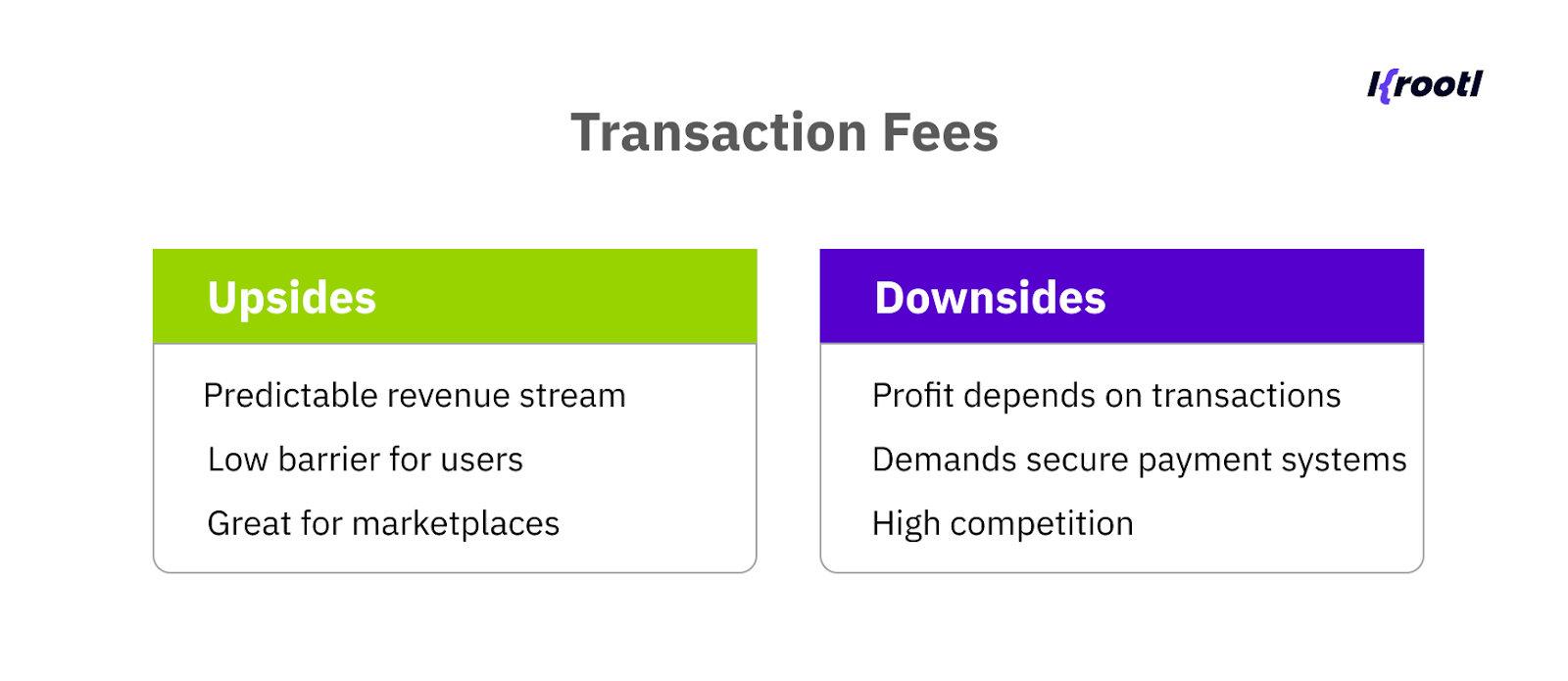
Pros:
- Predictable revenue stream: Scales with the volume of transactions
- Low barrier for users: No upfront cost to download or use the app
- Great for marketplaces and on-demand services
Cons:
- Revenue depends on transaction frequency and size
- Requires secure payment infrastructure and compliance (e.g., PCI DSS)
- High competition: Margins may be squeezed in crowded markets
For example, in our case study on building a freelancer hiring platform for the Netherlands market, the transaction fee model was carefully aligned with an SEO-first design and a user-friendly experience, ensuring both visibility and steady revenue growth.
10. Crowdfunding
The crowdfunding model raises funds directly from users or supporters before or during app development. It’s particularly effective for niche apps, startups, or innovative ideas that need early validation and community backing.
How It Works
Developers pitch their app concept on platforms like Kickstarter, Indiegogo, or Patreon. Users contribute funds in exchange for early access, rewards, or exclusive features. Crowdfunding is often combined with other monetization methods once the app is launched.
Example
A creative storytelling app that offers backers early access to exclusive chapters or premium features after launch.
Pros:
- Early validation: Tests market interest before full development
- No need for external investors: Funding comes directly from future users
- Builds a loyal community: Supporters feel invested in the app’s success
Cons:
- Unpredictable revenue: Campaigns can fail to meet targets
- High marketing effort: Requires a strong pitch and ongoing promotion
- One-time funding: Not a sustainable long-term monetization method
Hybrid Models
The hybrid monetization model combines two or more strategies — for example, a freemium approach supported by in-app purchases, ads for free users, or premium subscriptions for advanced features. This flexibility allows apps to diversify revenue streams and target different user segments.
How It Works
An app may offer a free version with ads (in-app advertising), while encouraging users to upgrade to a premium subscription for an ad-free experience. Some apps mix in-app purchases, affiliate links, or transaction fees to optimize monetization and user engagement.
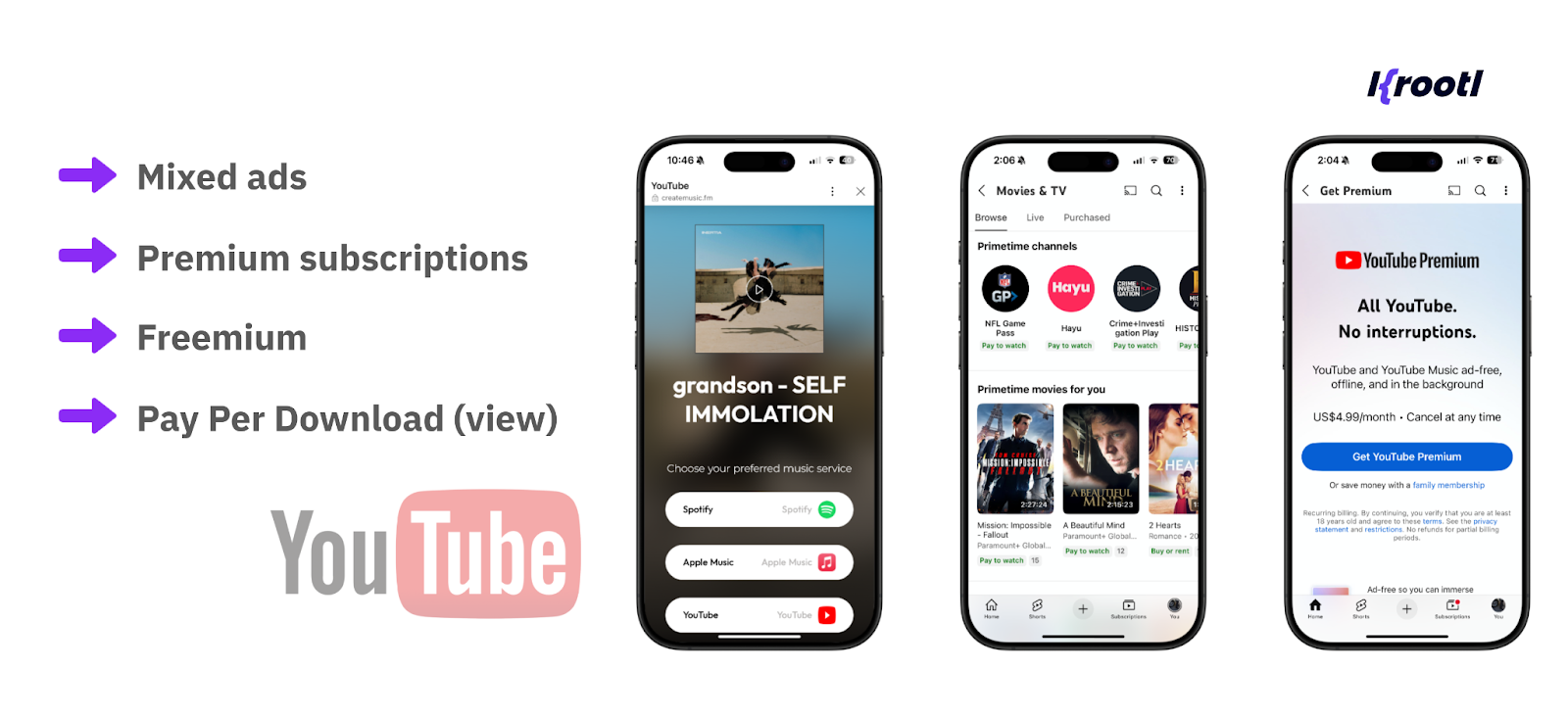
Pros:
- Maximized revenue: Targets both free and paying users
- Flexibility: Allows experimenting with multiple income sources
- Better user segmentation: Users can choose how they want to pay (ads vs. subscriptions)
Cons:
- Complex strategy: Managing multiple monetization streams can require constant optimization
- Risk of clutter: Mixing too many models can harm user experience
Examples
- Spotify – Combines freemium, subscriptions, and ads
- Duolingo – Free with ads, plus premium subscriptions and in-app purchases
- YouTube – Mixes ads, premium subscriptions, and memberships
With so many monetization models available – from simple ads to hybrid strategies – there’s no one-size-fits-all approach. The right model depends on the app’s purpose, audience, and long-term goals. What works for a music streaming app like Spotify might not make sense for a fitness tracker or an education platform.
Key Factors to Consider Before Choosing a Mobile Monetization Strategy
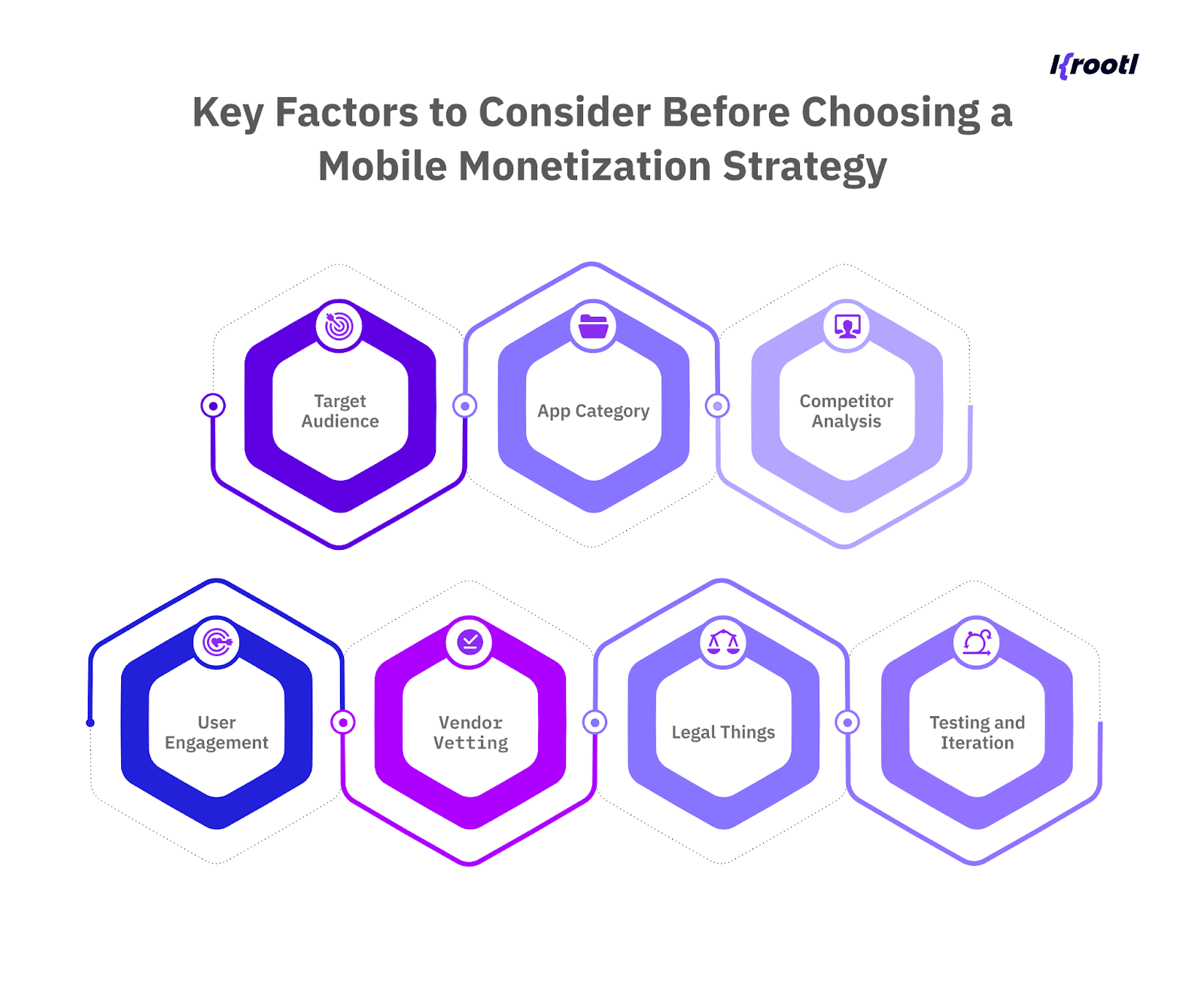
- Target Audience
Who are the users? What are they willing to pay for — convenience, premium features, or ad-free access? For instance, users of productivity or wellness apps are often open to subscriptions, while casual gamers may prefer free apps supported by ads or in-app purchases. - App Category and Use Case
Some models are naturally better suited for specific categories
- Gaming apps thrive on in-app purchases and rewarded ads
- Streaming platforms work well with subscriptions
- Marketplaces often rely on transaction fees
Retail apps, for instance, increasingly rely on smart revenue strategies and seamless user experiences to stay ahead. We covered how digital solutions reshape retail in our article Quick Commerce in Retail and How Your Business Can Benefit.
- Competitor Analysis
Looking at how similar apps monetize can reveal what users expect — and what gaps you can fill. If competitors use subscriptions, a hybrid freemium model might help differentiate your product. - User Retention and Engagement
The monetization strategy should support long-term user engagement. Subscriptions require consistent content updates, while ads or in-app purchases benefit from high daily activity. - Vendor Vetting
Partnering with the right ad networks, payment processors, or analytics providers is essential. Check their reliability, payout structures, and technical support to avoid issues down the line. - Legal Considerations
Monetization often involves user data, so compliance with regulations like GDPR, CCPA, or PCI DSS is non-negotiable. Clear data policies and secure systems build trust and prevent legal risks. - Testing and Iteration
The best monetization approach often comes from experimentation. Start with one model, analyze the data, and adjust. Many apps evolve into hybrid strategies based on user behavior and feedback.
How to Measure the Success of Your App Monetization Strategy
A monetization strategy isn’t effective unless it drives both revenue and user satisfaction. The key is tracking metrics that reflect real performance, user engagement, and long-term value.
Key Metrics to Track:
1. ARPU (Average Revenue Per User)
Shows how much revenue each user generates on average. Helps evaluate if the monetization model is sustainable.

2. LTV (Customer Lifetime Value)
Estimates the total revenue from a user throughout their time with the app. A high LTV usually means strong retention and effective upselling.

3. Conversion Rate
Tracks how many free users convert to paying customers (e.g., via subscriptions or in-app purchases).

4. Retention Rate
Measures how many users return after their first session. Monetization fails if users abandon the app early.

5. Churn Rate
The flip side of retention — how many users stop using the app. Helps identify monetization models that harm user experience.

6. eCPM (Effective Cost Per Mille)
For apps using advertising, this shows how much revenue is earned per 1,000 ad impressions.
Monetization & Flutter App Development: Why It Works
Monetizing a mobile app – whether through ads, subscriptions, or in-app purchases – isn’t just about picking a revenue model. The technology behind the app plays a crucial role in how easily that model can be implemented and maintained.
Separate builds for iOS and Android often slow development down, increase costs, and complicate updates. Flutter app development solves this with a single codebase that works across platforms, making it faster, more cost-efficient, and easier to maintain.
After delivering numerous projects with Flutter, we’ve seen how it simplifies development and eliminates many of the common pain points. Its ready-to-use tools — from AdMob integration and in-app purchases to subscription management and analytics — make rolling out monetization features seamless while ensuring a consistent experience for users.
Why Flutter Works for Monetization
- Cross-platform consistency: Monetization logic is implemented once and deployed on both platforms.
- Rich plugin ecosystem: Flutter supports packages like google_mobile_ads for AdMob, in_app_purchase for subscriptions, and firebase_analytics for performance tracking.
- Speed and cost efficiency: A unified codebase reduces both development time and budget.
- Polished UI/UX: Flutter’s widgets make paywalls, ads, and purchase flows look seamless and user-friendly.
For a deeper look at why Flutter is a smart choice for businesses in 2025, read our article Why Choosing Flutter is a Smart Business Decision in 2025.
Wrap Up
There’s no one-size-fits-all approach to mobile app monetization. The right strategy depends on your app’s purpose, audience, and the value it delivers. What matters most is finding a model that not only generates revenue but also enhances the user experience.
At Krootl, we don’t just build apps – we create products designed to grow and succeed. Our Flutter app development team helps clients choose and implement the right monetization model, backed by strong analytics and scalable technology.
From shaping the initial concept to post-launch optimization, we focus on building apps that are both user-friendly and revenue-ready. If you’re exploring monetization strategies for your next app, we’re here to help you turn an idea into a product that performs and earns.








